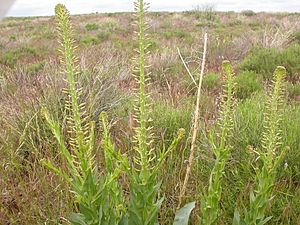Stanleya viridiflora facts for kids
Quick facts for kids Stanleya viridiflora |
|
|---|---|
 |
|
| Scientific classification | |
| Genus: |
Stanleya
|
| Species: |
viridiflora
|
Stanleya viridiflora, also known as green princesplume or green-flowered prince's plume, is a beautiful flowering plant. It belongs to the Brassicaceae family, which also includes plants like cabbage and broccoli! This plant grows naturally in the western parts of the United States. You can often find it in areas with sagebrush and on high plateaus. It likes to grow in rocky soils, including those made of limestone, sandstone, clay, shale, or even volcanic soil.
Contents
Discover the Green Princesplume
The green princesplume is a plant that lives for many years. It grows a strong, straight stem that can reach over a meter (about 3 feet) tall! This stem is usually smooth and sometimes feels a bit waxy.
What Does It Look Like?
At the bottom of the plant, there's a thick base called a caudex. This base is often covered with old, dried-up leaf parts.
Leaves and Flowers
The leaves of the green princesplume can be long and shaped like a spear or an oval. Their edges can be smooth, slightly toothed, or even divided into a few sections. Some leaves can grow up to 22 centimeters (about 8.5 inches) long! Some leaves have long stems, while others, especially those higher up, wrap around the main stem.
At the top of the stem, you'll see a long cluster of many flowers. This is called an inflorescence. Each flower bud is covered by long, thick outer leaves called sepals. When these sepals open, they show off yellow or whitish petals. Each petal can be up to 2 centimeters (about 0.8 inches) long.
Stamens and Seeds
From the center of the flower, long parts called stamens stick out. These stamens are usually 1 or 2 centimeters long. After the flower blooms, it produces a curved, worm-like fruit called a silique. This fruit is about 4 to 7 centimeters (about 1.5 to 2.7 inches) long and holds many tiny seeds inside.

